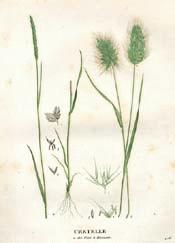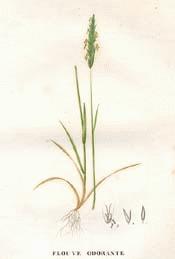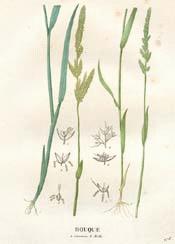
GrassesFamily: N.O. Graminaceae
COUCH-GRASSBotanical: Agropyrum repens (BEAUV.)---Synonyms---Twitch-grass. Scotch Quelch. Quick-grass. Dog-grass. Triticum repens (Linn.).---Part Used---Rhizome. ---Habitat---Couch-grass is widely diffused, being not only abundant in fields and waste places in Britain and on the Continent of Europe, but also in Northern Asia, Australia and North and South America. It was formerly known as Triticum repens, though now assigned to the genus Agropyrum. Among these the Couch-grass (Agropyrum repens) is pre-eminent, though anything but a favourite with the farmer, for it has a slender, creeping rhizome, or underground stem, which extends for a considerable distance just beneath the surface of the ground, giving off lateral branches occasionally, and marked at intervals of about an inch by nodes, from which leaf-buds and slender branching roots are produced. These long, creeping, subterranean stems increase with great rapidity, and the smallest piece left in the ground will vegetate and quickly extend itself, so that it is almost impossible to extirpate it when once established in the soil, while its exhaustive powers render it very injurious to the crops. Its very name, Couch, is supposed to be derived from the Anglo-Saxon, civice (vivacious), on account of its tenacity of life. It is said that the only way to extirpate it, is to lay the ground down in pasture for some years, when the Couch will soon be destroyed by the close-growing Grasses, for it flourishes only in loose soil. The name Agropyron is from the Greek agros (field), and puros (wheat). On sandy seashores, the grass is often very abundant and assists in binding the sand and preventing the dunes from shifting, its long rhizome answering the purpose nearly as well as those of the Mat and Lyme Grasses. Though commonly regarded in this country as a worthless and troublesome weed, its roots are, however, considered on the Continent to be wholesome food for cattle and horses. In Italy, especially, they are carefully gathered by the peasants and sold in the markets. The roots have a sweet taste, somewhat resembling liquorice, and Withering relates that, dried and ground into meal, bread has been made with them in time of scarcity. ---Description---From its long creeping, pointed root-stock, it produces in July several round, hollow flower stems, 2 to 3 feet high, thickened at the joints, bearing five to seven leaves and terminated by long, denselyflowered, two-rowed spikes of flowers, somewhat resembling those of rye or beardless wheat, composed of eight or more oval spikelets on alternate sides of the spike, each containing four to eight florets, the awns, when present, being not more than half the length of the flower. The leaves are flat, with a long, cleft sheath, and are rough on the upper surface, having a row of hairs on each principal vein. One of the names of this grass is Dog'sgrass, from its efficacy in relieving dogs when ill. They are often to be seen searching for its rough leaves, which they chew in order to procure vomiting. Culpepper closes his description of the grass by saying: 'If you know it not by this description, watch the dogs when they are sick and they will quickly lead you to it,' and concludes his account of its medicinal virtues with: 'and although a gardener be of another opinion, yet a physician holds half an acre of them to be worth five acres of carrots twice told over.'
The juice of the roots drank freely is recommended by Boerhaave in obstruction of the viscera, particularly in cases of scirrhous liver and jaundice, and it is noteworthy that cattle having scirrhous livers in winter soon get cured when turned out to grass in spring. Sheep and goats eat the leaves as well as cows, horses eat them when young, but leave them untouched when fully grown. The ancients were familiar with a grass under the names of Agrostis and Gramen - having a creeping root-stock like the Couchgrass. Dioscorides asserts that its root, taken in the form of decoction is a useful remedy in suppression of urine and stone in the bladder. The same statements are made by Pliny, and are found in the writings of Oribasius and Marcellus Empiricus in the fourth century and of Ætius in the sixth century, and figures of the plant may be found in Dodoens's herbal. The drug is also met with in the German pharmaceutical tariffs of the sixteenth century. Formerly the decoction of Couch-grass roots was a popular drink taken to purify the blood in spring. The drug is still a domestic remedy in great repute in France, being taken as a demulcent and sudorific in the form of a tisane. Readers of Trilby will remember Little Billee being dosed with this, as most Parisians have been. The French also use the Cocksfoot-grass (Cynodon Dactylon), which they term Pied-de-poule, in a similar way and for a similar purpose. ---Part Used---The rhizome, or underground stem, collected in the spring and freed from leaves and roots. Couch-grass rhizome is long, stiff, pale yellow and smooth, about 1/10 inch in diameter, hollow except at the nodes and strongly furrowed longitudinally, with five or six longitudinal ridges. Where the nodes occur, traces of rootlets may be found on the under surfaces and the fibrous remains of sheathing leaf-bases on the upper surfaces, but all traces of rootlets and leaves must be removed before use. As found in commerce, the rhizome is always free from rootlets, cut into short lengths of 1/8 to 1/4 inch and dried, being thus in the form of little shining, straw-coloured, many-edged tubular pieces, which are without odour, but have a sweet taste. ---Constituents---Couch-grass rhizome contains about 7 to 8 per cent of Triticin (a carbohydrate resembling Inulin) and yielding levulose on hydrolysis. It appears to occur in the rhizome of other grasses, and possibly is widely diffused in the vegetable kingdom. Sugar, Inosite, Mucilage and acid malates are also constituents of the drug. Lactic acid and mannite may occur in an extract of the rhizome, but are understood to be fermentation products. Starch is not present and no definite active constituent has yet been discovered. The rhizome leaves about 4 1/2 per cent ash on incineration. ---Medicinal Action and Uses---Diuretic demulcent. Much used in cystitis and thetreatment of catarrhal diseases of the bladder. It palliates irritation of the urinary passages and gives relief in cases of gravel. It is also recommended in gout and rheumatism. It is supposed to owe its diuretic effect to its sugar, and is best given in the form of an infusion, made from 1 OZ. to a pint of boiling water, which may be freely used taken in wineglassful doses. A decoction is also made by putting 2 to 4 oz. in a quart of water and reducing down to a pint by boiling. Of the liquid extract 1/2 to 2 teaspoonsful are given in water. Couch-grass is official in the Indian and Colonial Addendum of the British Pharmacopoeia for use in the Australasian, Eastern and North American Colonies, where it is much employed. ---Substitutes---Agropyrum acutum (R. et S.) A. pungens (R. et S.) and A. junceum (Beauv.), by some botanists regarded as mere maritime varieties of A. repens, have root-stocks similar to the latter. COUCH-GRASS, DOG'S TOOTHBotanical: Cynodon dactylon (PERS.)---Synonyms---(French) Chien-dent. Pied-de-poule.---Part Used---Rhizome. Cynodon dactylon (Pers.), a grass very common in the south of Europe and the warmer parts of Western Europe, also indigenous to Northern Africa as far as Abyssinia, affords the Gros Chien-dent or Chiendent and Pied-de-poule of the French. It is a rhizome differing from that of Couch-grass, in being a little stouter and in containing much starch, of which there is no trace in Couch-grass. Under the microscope it displays an entirely different structure, inasmuch as it contains a large number of much stronger fibrovascular bundles and a cellular tissue loaded with starch, and is, therefore, in appearance much more woody. It thus approximates to the rhizome of Carex arenaria (Linn.) which is as much used in Germany as that of Cynodon in France and Southern Europe. The latter appears to contain Asparagin, or a substance similar in composition to it. The herb of Hygrophila spinosa (Linn.) has been used for the same purpose as Couchgrass rhizome, and was formerly included in the Indian and Colonial Addendum to the British Pharmacopoeia. It contains much mucilage. [Top] DARNEL, BEARDEDBotanical: Lolium temulentum (LINN.)---Synonyms---Ray-grass. Drake. Cheat.(Old English) Cokil. (French) Ivraie. (Arabic) Zirwan. ---Part Used---Seeds. The Bearded Darnel, a common grass weed in English cornfields, is easily distinguished by its long glumes or awns and turgid, fruiting pales, containing the large grains, from the common Ray or Rye-grass (Lolium perenne), which is one of the best of the cultivated grasses, peculiarly adapted for both hay and pasture, especially in wet or uncertain climates. Both are often indiscriminately called Darnel or Ray-grass. The seeds or grains of the Bearded Darnel were used medicinally by the ancient Greeks and Romans, but were never official in our Pharmacopoeia. The admixture of the grain with those of the nutritious cereals amongst which it is often found growing should be guarded against, as its properties are generally regarded as deleterious. Gerard tells us: 'the new bread wherein Darnel is eaten hot causeth drunkenness.' When Darnel has been given medicinally in a harmful quantity, it is recorded to have produced all the symptoms of drunkenness: a general trembling, followed by inability to walk, hindered speech and vomiting. For this reason the French call Darnel: 'Ivraie,' from Ivre (drunkenness); the word Darnel is itself of French origin and testifies to its intoxicating qualities, being derived from an old French word Darne, signifying stupefied. The ancients supposed it to cause blindness, hence with the Romans, lolio victitare, to live on Darnel, was a phrase applied to a dim-sighted person. The alleged poisonous properties of Darnel are now generally believed to be due to a fungus. Darnel is in some provincial districts known as Cheat, and there is reason to suspect that the old custom of using Darnel to adulterate malt and distilled liquors has not been entirely abandoned. Culpepper terms it 'a pestilent enemy among the corn,' and in olden days its name was so commonly used as a synonym for a pernicious weed that it has been said that the expression in Matthew xiii. 25, would have been better translated Darnel than tares. The Arabs still give the name zirwan to a noxious grass (which is only too common in the cornfields of Palestine) simulating the wheat when undeveloped, though easily distinguishable at 'harvest' time. In connection with this similarity, it may be of interest to relate an experiment made by a friend of the writer. She procured some ears of Palestine wheat and also some of Palestine 'Darnel' ('tares'), for the purpose of illustrating the truth of the Parable of the Tares to her Bible-class. After sowing both kinds in a patch of ground she asked her scholars to watch the appearance of the respective 'blades' as they appeared. They attached small strands of wool to distinguish each. In many cases wheat grew from the tare seeds, and tares from the wheat. It is said that the country people of Cheshire believed Darnel to be 'degenerated wheat.'
[Top] [Top of Darnel, Bearded] ---Medicinal Action and Uses---Darnel is usually regarded as possessing sedative and anodyne properties. It was not only employed medicinally by the Greeks and Romans and in the Middle Ages, but in more modern practice in the form of a powder or pill in headache, rheumatic meningitis, sciatica and other cases. Cases are on record of serious effects having resulted from the use of bread, containing by accidental admixture the flour of Darnel seeds. Chemically the seeds contain an acrid fixed oil and a yellow glucoside, but as far as microscopical appearances indicate, the Darnel contains nothing that is not contained in wheat, and analysis has not yet revealed its poisonous elements. Of late years, it has been questioned whether the ill-effects of Darnel are inherent in the grain themselves, or whether they may not be ascribed to their having been ergotized. Lindley in his Vegetable Kingdom takes the latter view, stating moreover, 'this is the only authentic instance of unwholesome qualities in the order of grasses,' and Professor Henslow considers too that as the use of Darnel in the sixteenth century was similar to that of Ergot - a diseased condition of the grain of Rye - it is more probable that the injurious nature of Darnel has been due to an ergotized condition, especially as experiments have shown that perfectly healthy Darnel seeds have no injurious effects. [Top] [Top of Darnel, Bearded] VERNAL GRASS, SWEET SCENTED
Botanical: Anthoxanthum odoratum (LINN.)---Part Used---Flowers.The Sweet-scented Vernal Grass - with yellow anthers, not purple, as so many other grasses - gives its characteristic odour to newly-mown meadow hay, and has a pleasant aroma of Woodruff. It is, however, specially provocative of hay fever and hay asthma. The flowers contain Coumarin, the same substance that is present in the Melilot flowers, and the volatile pollen impregnates the atmosphere in early summer, causing much distress to hay-fever subjects. The sweet perfume is due chiefly to benzoic acid. A medicinal tincture is made from this grass with spirit of wine, and it said that if poured into the open hand and sniffed well into the nose, almost immediate relief is afforded during an attack of hay fever. It is recommended that 3 or 4 drops of the tincture be at the same time taken as a dose with water, repeated if required, at intervals of twenty to thirty minutes. The name Anthoxanthum is from the Greek anthos (flower) and xanthos (yellow). [Top] [Top of Vernal Grass, Sweet Scented] ---Other Species--- A. Puelii is a smaller species than A.odoratum, with many slender much-branched stems; lax panicles; long, slender awns, and a fainter perfume. It occurs occasionally as a modern introduction in sandy fields. Flowers from July to September. The following British grasses have varying degrees of utility, though are not all medicinally valuable. COMMON CORD-GRASS
CANARY - GRASS
SOFT-GRASS
DOG'S-TOOTH GRASS
REED
The runners are nutritious, containing much sugar, and might be used as fodder. Name said to be from the Greek, phragma (a hedge). CRESTED DOG'S-TAIL
PURPLE MOLINIA
WATER WHORL-GRASS
REED MANNA-GRASS
It is a fine covert for waterfowl. SCENTED GRASSESAmong the Grasses may be included the SCENTED GRASSES, growing in tropical climates, largely cultivated in India, Ceylon and the Straits Settlements. They furnish very important essential oils for perfumery.LEMONGRASS OIL is prepared from Cymbopogon citratus, formerly known as Andropogon Schoenanthus, a species growing abundantly in India and cultivated in Ceylon and Seychelles. It owes its scent almost entirely to its chief constituent, citral, and is one of the chief sources of the citral used in the manufacture of Tonone or artificial violet perfume. It is sometimes called Oil of Verbena from its similarity to the odour of the true Verbena Oil which is rarely found in commerce. It is frequently used to adulterate Lemon Oil. Samples of the oil produced experimentally in the West Indies, Uganda, and new districts of India were examined in the laboratories of the Imperial Institute in 1911, and as a result of the recommendations made, the production of Lemongrass has been taken up on a considerable scale in Uganda. CITRONELLA OIL is derived from C. nardus, grown in Ceylon, Java and Burmah. The oil is distilled on an enormous scale and used for perfuming the cheapest household soaps and in the manufacture of coarse scents, and is also added as an adulterant to more expensive oils. Its scent is chiefly due to two substances, Geraniol and Citronellel. PALMAROSA, Rosha or Indian Geranium Oil, is derived from C. martine. It is grown in India and was formerly known as 'Turkish Geranium Oil,' because it was imported into Europe via Turkey and Bulgaria as an adulterant to Otto of Roses. It has a strong geranium-like odour and is used in the commercial preparation of pure Geraniol, its chief constituent. The distillation of this oil was started in the eighteenth century. GINGERGRASS OIL is also the product of the last-named grass, an oil of poorer quality, which is only suitable for cheap perfumes. See SEDGES. [Top of Scented Grasses]
Purchase this Herb from Botanical.com (Barley Grass)
© Copyright Protected 1995-2004 botanical.com
|




